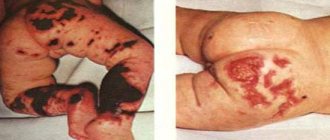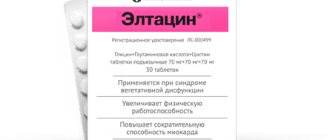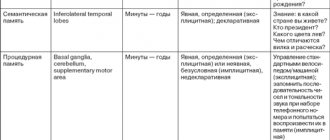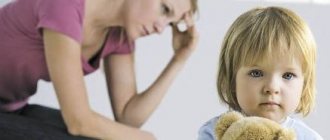Clinical manifestations
Regardless of the nature of its occurrence, the clinical picture of meningitis has a set of common symptoms:
- General infectious symptoms - the most serious symptom is the occurrence of intoxication, which leads to the development of various disorders in the body (for example, hormonal disorders, water-salt disorders, etc.).
- Meningeal syndrome - this process is caused by the occurrence of inflammatory processes in the meninges. Conventionally, it is divided into general cerebral symptoms (photophobia, dizziness, headache) and meningeal symptoms (Kernig's, Brudzinski's symptoms, etc.).
- Changes in the cerebrospinal fluid (for example, with purulent meningitis, turbidity of the cerebrospinal fluid is observed, the amount of protein increases, etc.).
Treatment
To carry out full treatment, the child must be taken to the hospital, where he is examined by a doctor.
Treatment is carried out by a doctor
To help the patient, the doctor may use:
- Antibacterial therapy. It is commonly used to treat bacterial meningitis. Only a doctor can select the appropriate drug, having previously established the type of pathogen. The doctor prescribes streptomycin punctures, which are injected into the spinal canal; this therapy is performed for tuberculosis. In case of viral meningitis, the doctor must monitor the patient and also prescribe symptomatic treatment to alleviate the child’s condition.
- The doctor uses methods that help normalize intracranial pressure. The fact is that in any form of this disease, the amount of cerebrospinal fluid increases, for this reason severe headaches occur. To reduce pressure, a puncture of the cerebrospinal fluid is taken, this helps to reduce the amount of fluid, which will reduce the pressure. Additionally, the use of diuretic medications is recommended.
- It is important to carry out symptomatic treatment; it includes the use of antipyretics, vitamin complexes, as well as antiemetic medications and painkillers.
- The doctor uses special therapy, which is aimed at reducing intoxication of the body, and also uses saline solutions to restore water and salt balance in the body.
- If there is such a need, the patient is prescribed medications that reduce the number of seizures or eliminate these seizures.
- Hormonal agents can be used against inflammation; they are used only after a doctor’s prescription.
Why do spots appear?
The appearance of spots on a child's skin is a very dangerous symptom of meningitis .
This phenomenon is called meningeal rash, and, as a rule, begins from the legs, gradually rising higher and higher. The main reason for the appearance of spots lies in the harmful effects of meningococci on the child’s body. As a rule, the appearance of a rash is characteristic of purulent meningitis, so it is necessary to begin treatment urgently, otherwise the consequences can be very dire.
Does it happen without fever?
It should be noted that often not always a child may experience a full set of symptoms characteristic of meningitis . In particular, an increase in body temperature is not necessary. It may remain at the same level.
IMPORTANT : However, in any case, at the slightest suspicion that a child has this disease, it is necessary to urgently contact a medical institution, since sometimes the count may not be days, but hours.
You should especially carefully monitor the condition of infants, since they cannot express in words what exactly is bothering them.
How to protect a child?
In order to protect your baby from such a dangerous disease, you should use only boiled or bottled water for drinking and cooking.
It is also important to monitor the cleanliness of the child’s body and accustom him to regular hygiene procedures.
It is necessary to avoid swimming in bodies of water that are not intended for this purpose. To boost your child’s immunity, you should eat right and be outside more often.
To prevent widespread infectious diseases in Russia, routine vaccination against measles, poliomelitis and mumps is carried out. These vaccinations are a good help against complications of viral meningitis.
How to recognize at home?
There are several of the most striking childhood symptoms of meningitis, the appearance of which directly signals a developing disease. As mentioned above, these symptoms are called meningeal. Thus, knowing the meningeal symptoms, you can check for meningitis in your child at home . So, let's look at them in detail.
Kernig's symptom - is expressed in the fact that the patient, lying on his back with his leg bent at the knee and also at the hip joint, cannot straighten it due to the fact that the muscles of the back of the thigh are in severe spasm. At the same time, trying to bend one leg, the second also begins to reflexively bend.
Brudzinski's symptoms contain a set of signs indicating damage to the membranes of the brain.
So, there are the following 4 symptoms that can be used to identify meningitis in a child, even at home:
The upper Brudzinski symptom is expressed in the fact that when trying to bring the patient’s chin closer to the chest, there is strong resistance from the neck muscles, as well as flexion of both legs at the knee and hip joint.- The average Brudzinski symptom is when light pressure is applied to the patient’s pubic bone, and the leg is pulled toward the abdomen. This is a positive sign.
- The lower Brudzinski symptom is a kind of Kering symptom. If, when trying to bend the patient’s leg at a right angle at the knee and hip joints, the second leg involuntarily begins to be pulled towards the stomach, then, accordingly, the lower sign can be considered positive.
- Brudzinski's buccal symptom - if, when pressing on a point located just below the zygomatic arch, the patient bends the arm at the elbow joint and raises the wrist, then accordingly this sign can be considered positive.
Brudzinski's symptoms in children at an early age are usually very mild.
Ankylosing spondylitis's symptom is called the zygomatic symptom , and is expressed in the fact that when lightly tapping the cheekbones with a hammer, the patient experiences a severe headache, and a painful grimace appears on the face. This indicates pathological processes occurring in the brain.
Expert opinion
Zemlyanukhina Tatyana Vyacheslavovna
Ambulance and emergency paramedic at the Clinical Emergency Hospital #7 in Volgograd.
Ask an expert
Meningitis has its own set of symptoms by which you can determine the presence of the disease at home. But most often, especially in children, the disease begins asymptomatically or is accompanied by such nonspecific manifestations as irritability or drowsiness.
Symptoms of meningococcal infection
Manifestations of meningococcal infection are insidious and deceptive. The first symptoms are nonspecific; making a correct diagnosis at the initial signs of the disease can be very difficult. However, when a detailed picture of the disease appears, the patient often cannot be saved. There are three forms of meningococcal infection, each of which can occur separately and independently, or have a sequential development: from nasopharyngitis to sepsis and meningitis.
Meningococcal nasopharyngitis:
The symptoms of menigococcal nasopharyngitis are similar to those of the common cold. This is an increase in temperature, to an average of 38? C, as well as the familiar and not particularly worrying symptoms of a cold: runny nose, sore throat, headache. Unlike a common ARVI, when there is increased sweating and redness of the skin, with meningococcal nasopharyngitis the skin is pale and dry.
It is very important to identify “unusual” symptoms among the signs of a common cold, and not to miss the deterioration of the condition, which may develop too quickly - faster than you expect.
Symptoms common to meningitis and meningococcemia:
- Fever (which may not respond to antipyretics);
- Nausea and vomiting;
- Weakness;
- Confusion and disorientation in time, space;
- Dizziness;
- Restlessness and excitement.
Symptoms characteristic of meningitis:
- Severe headache that does not go away after taking painkillers;
- Backache;
- Pain and difficulty moving in the neck;
- Intolerance to bright light;
- Cramps.
Symptoms characteristic of meningococcemia:
- High fever up to 39-40? C, accompanied by coldness of the hands and feet;
- Chills;
- Pain in muscles and joints;
- pain in the abdomen or chest;
- Pale skin, sometimes with a gray tint;
- Rapid breathing;
- Diarrhea;
- Rash: begins with pink spots 2-10 mm in size, then turns into purple spots of irregular (star-shaped) shape that do not protrude above the surface of the skin and do not disappear with pressure. They most often start from the buttocks, torso, and legs.
It is necessary to regularly examine the patient for rashes: the appearance of any spots on the skin should be grounds for calling an ambulance. However, you should not wait for the rash to appear - the rash may be a late symptom or may not appear at all. If several of these signs (not necessarily all) appear, you should immediately consult a doctor.
How does meningococcemia develop?
In some patients, meningococcus overcomes local immunity barriers and enters the blood, where it dies and disintegrates. Massive decay of meningococci with the release of endotoxin (a strong vascular poison) leads to catastrophic consequences. Blood clotting begins, and microthrombi form throughout the circulatory system, obstructing blood flow. This is called DIC syndrome ("disseminated intravascular coagulation syndrome", the word "disseminated" means "scattered, widespread"). As compensation, the body's anticoagulant system is activated and the blood thins. By this time, both the coagulation system and the anticoagulation system are exhausted.
As a result, chaotic multidirectional changes occur in the hemocoagulation system - blood clots and bleeding. Extensive hemorrhages appear in various organs and tissues, including the adrenal glands. The adrenal glands normally produce corticosteroid hormones, which increase blood pressure and suppress inflammation and the immune system. Hemorrhage into the adrenal glands leads to acute adrenal insufficiency with an additional drop in already reduced blood pressure. A rash due to meningococcemia and there are multiple hemorrhages in the skin.
Meningococcemia begins suddenly or after a runny nose. When meningococci enter the blood, chills occur, the temperature rises to 38-39° C, muscle and joint pain, headache, and often vomiting appear. At the end of the first - beginning of the second day, the most characteristic symptom appears - a hemorrhagic rash, which is called “star-shaped”. Please note: the rash does not disappear with pressure. The elements of this rash have irregular contours, “star-shaped”, “processed”; against a pale skin background they resemble a picture of a starry sky.
The rash is located mainly on sloping (lower) places - on the lateral surfaces and lower part of the body, on the thighs. Necrosis appears in the center of hemorrhages, the rash darkens, becomes larger, its number increases, and sometimes becomes confluent, affecting large areas. Most often these are the distal (remote) parts of the limbs, the tips of the toes, and hands. Necrosis (death) and dry gangrene of the ears, nose, and phalanges of the fingers are possible. The appearance of a rash on the face, eyelids, sclera, and ears is also an unfavorable sign. If a rash occurs in the first hours from the onset of the disease, this is a prognostically unfavorable sign and is typical for very severe forms of the disease.
Acute adrenal insufficiency due to hemorrhage in the adrenal glands resembles the clinical picture of any shock: the patient is in serious condition, pale, wet, the upper blood pressure is 60-80 and below.
If you find signs of shock or a “star-shaped” rash in a patient, immediately call an intensive care team or resuscitation team. The principles of treatment for meningococcemia are as follows:
- a large dose of glucocorticoid hormones intravenously. Goal: dampen the body's overreaction to meningococcus and stop the breakdown of bacteria, maintaining blood pressure levels. - an antibiotic that stops the development of bacteria, but does not destroy them. Such antibiotics are called bacteriostatic (chloramphenicol, etc.). Goal: Bacteria should not die and undergo decay to release endotoxin, but also should not be allowed to multiply under conditions where the immune system is suppressed by the administered glucocorticoids. - treatment of shock: intravenous infusion of saline, rheopolyglucin, etc.
Meningitis.
It is possible for meningococcus to enter various organs and tissues, but more often it gets into the brain - meningitis develops. Meningitis is an inflammation of the meninges.
Inflammation of the brain matter is called encephalitis. Meningitis also begins acutely with chills and fever. Characteristic signs of meningitis:
-Strong headache,
-increased sensitivity to all external stimuli (light, sounds, touches). Any sound, any bright light hurts,
-vomiting (due to increased intracranial pressure), which does not bring relief. (Food poisoning gets better after vomiting.)
- disturbances of consciousness (drowsiness, confusion).
- meningeal symptoms (identified by a health care provider) are associated with the fact that muscle regulation is disrupted and extensor tone begins to predominate. The neck becomes rigid (that is, stiff, hard, and difficult to bend).
Kernig's sign.
In a patient with meningitis lying on his back, it is impossible to straighten the leg at the knee joint, which was previously bent at a right angle at the knee and hip joints (normally this can be done). In newborns, Kernig's symptom is physiological and persists for up to 3 months.
The upper Brudzinski sign consists of bending the legs and pulling them towards the abdomen while attempting to bend the head towards the chest. Normally, the legs should not bend.
In advanced cases (which should not happen!) the patient takes a forced “cooper dog” or “cocked gun” pose. Meningococcus becomes active during influenza epidemics
Cold and flu season is a very favorable time for the active spread of an infection such as meningitis. It is its pathogens that pass from the carrier of meningococcus to a healthy person when coughing and sneezing. Moreover, most often the carriers are adults, without even knowing it, and mostly children get sick.
Meningitis can be caused by a variety of pathogens: meningococcus, pneumococcus, Haemophilus influenzae and even the herpes simplex virus, which usually affects the mucous membrane of the lips. The insidiousness of this infection is that the initial clinical manifestations of the disease resemble a cold or flu. For example, this happens with such a clinical form of meningitis as nasopharyngitis, when the back wall of the pharynx becomes inflamed. Patients cough, have a stuffy nose, and a sore throat. At this stage, patients are most often diagnosed with acute respiratory disease. However, incorrect and untimely diagnosis can further lead to inflammation of the meninges.
The most severe form of the disease is bacterial meningitis. In this case, the disease begins suddenly. For example, a child goes to bed completely healthy, but at night he suddenly becomes restless and feels muscle weakness; if verbal contact is possible with the child, he will complain of a severe headache. Within an hour, the temperature usually rises to 39-40°, after 5-6 hours vomiting occurs. But the most dangerous symptom that you definitely need to pay attention to is the appearance of a rash. At first these are pale pink stars, but it is during the first day that they appear in 80% of patients. The rash will get larger. And if it is present, it is imperative to call the doctor again, since the primary diagnosis before the rash can be made as an acute respiratory disease.
Rash due to menigococcemia.
— Why is this form of meningitis dangerous? The fact that toxic-septic shock can develop due to hemorrhage in vital organs and, above all, in the adrenal glands. This shock causes death in 5-10 percent of patients. Therefore, the sooner parents seek medical help, and the sooner an appropriate diagnosis is made, the greater the chance that we will save a sick child. But in any case, hospitalization will be required and parents should not refuse it.
— Are there vaccinations against meningitis and what general preventive measures can be taken to avoid contracting this infection? There are vaccinations. Vaccination is recommended when an incidence of meningococcal infection is registered in the region of residence, before traveling to regions unfavorable for meningococcal infection, or traveling. Schoolchildren are required to be vaccinated if 2 or more cases of meningococcal infection are registered at school, pilgrims traveling to Hajj and tourists traveling to so-called countries. meningitis belt of Africa.
Prevalence of meningococcal infection
- Children under 5 years old. The immune system of children at this age is not fully formed; In addition, children tend to touch their mouths with unwashed hands and various objects; they still poorly observe the rules of general hygiene, such as covering their mouths when coughing and sneezing, and washing their hands. In addition, the spread of infection is facilitated by preschool institutions - nurseries, kindergartens, where children closely communicate with each other, exchange toys and food.
- Teenagers and young adults aged 15 to 25 - at this age people spend more time in nightclubs, which are characterized by a combination of many risk factors - crowding, smoking, shared drinks, kissing, the need to constantly shout above the noise.
- Smoking reduces both general immunity and local reactivity of the nasal mucosa and nasopharynx.
When is meningococcal infection most common?
The incidence is highest in winter and early spring.
This happens because the human immune system at this time is weakened by a large number of viruses, which are also activated at this time of year - ARVI, influenza, etc. In addition, hypothermia is an important trigger for the development of meningococcal infection. Complications of meningococcal infection Meningococcal infection, especially when occurring with the development of meningitis, often leaves behind irreversible consequences.
- Chronic headaches;
- Memory loss;
- Problems concentrating;
- Inappropriate behavior;
- Mood disorders;
- Vision problems;
- Deafness;
- Decreased intellectual abilities;
- Epilepsy;
- Paralysis is the loss of movement of any part of the body.
Complications of meningococcemia
- Scars form on the skin at the site of former hemorrhages; some defects require skin grafting operations.
- Due to impaired coagulability, blood clots form in the vessels of many organs, including the limbs, which can lead to the development of gangrene and subsequent amputation of fingers or toes, and sometimes the entire limb.
- Liver or kidney failure.
- Chronic fatigue syndrome.
Diagnosis of meningococcal infection
Due to the nonspecificity of the symptoms of meningococcal infection, even experienced doctors can make mistakes in diagnosis. Therefore, if during examination the doctor decides that high fever and intoxication are due to another infection, the patient’s condition should nevertheless be carefully monitored and the body examined for rashes. If the doctor decides that this is not a meningococcal infection, but the patient is getting worse, do not hesitate to call another doctor or take the patient straight to the hospital. To diagnose meningococcal infection, it is necessary to isolate the pathogen from biological fluids - blood, cerebrospinal fluid, joint fluid - or from a skin biopsy. The detection of meningococci in the nasopharynx does not indicate the presence of the disease, but only carrier status.
Prevention of meningococcal infection
You can become infected with meningococcal infection not only from a sick person, but also from healthy chronic carriers of meningococcus. To prevent infection, you must follow simple hygiene rules. You need to teach them to a child; and kindergarten teachers must carefully monitor their compliance.
Required rules:
- You cannot exchange drinks, food, ice cream, candy, or chewing gum;
- You cannot use other people’s lipsticks or toothbrushes; smoke one cigarette;
- Do not hold the tip of a pen or pencil in your mouth;
- You should not lick a baby's pacifier before giving it to your baby.
An important preventive measure is to identify carriage. When cases of meningitis appear, pediatricians examine the source of infection, epidemiologists identify contact people, take swabs from their nasopharynx, try to isolate meningococcus and then treat them with antibiotics if meningococcus is present. Prevention and measures in the outbreak. The main preventive measures are early detection and isolation of patients, sanitation of identified meningococcal carriers.
Drug prevention and vaccination against meningococcal infection
Drug prophylaxis: Antibiotic prophylaxis is necessary for everyone who was in contact with a sick person within 7 days before the onset of symptoms.
Vaccination: There are several types of meningococcus: serogroups A, C, W 135, Y. The most common are serogroups A and C. In Russia, vaccines are used against meningococci types A and C. The vaccine is particles of bacteria, so it is impossible to get sick after vaccination. The vaccination is usually well tolerated; slight redness may occur at the injection site. Vaccination is carried out once, the effectiveness is about 90%, immunity is formed on average within 5 days and lasts 3-5 years. Who needs to be vaccinated:
- If in closed groups - schools, kindergartens, military units, etc. 2 or more cases of meningococcal infection have been registered; all team members are subject to mandatory vaccination.
- Family members of a sick person and contact persons are subject to vaccination.
- When traveling to areas with a high incidence rate - to Saudi Arabia, the United Arab Emirates.
Measures to prevent meningococcal infection that parents should take:
1. Since this infection is transmitted by airborne droplets, the basis of the preventive measure is to reduce the child’s contact with sick people. During an increase in the incidence of influenza and ARVI, it is less likely to attend public events; if you have a cold, adults should wear a medical mask.
2. I would like to draw the attention of parents to such a circumstance as holding family celebrations. Infection is most often associated with them. For example, the birthday of a one-year-old toddler is celebrated. Parents invite guests, they try to babysit the baby, breathe on him, caress him, kiss him, and someone among them may be a carrier of meningococcus. Young children have a weak immune system and are very sensitive to such infections. As a result, the baby becomes infected and after 2-5 days he develops clinical symptoms of the disease. The fewer contacts a little person has with adults, the less likely it is that he will stumble upon a source of infection and get a serious illness.
3. In order not to infect a child, adults need to get rid of chronic diseases of the nasopharynx - pharyngitis, tonsillitis, laryngitis.
4. Increasing the body's defenses and immunity is also important for the child. The main protection for a baby is breast milk. Therefore, maintaining breastfeeding is the most important preventive measure.
5. Hardening the child.
6. Compliance with the rules of personal and public hygiene.
Symptoms in infants
REFERENCE! Meningitis in infants occurs in 1 child out of 100; children under one year of age are most often affected. Half of the sick die.
It's also worth reading about the MSD Handbook.
The first signs in children under one year old
During the incubation period of meningitis, infants develop symptoms:
- headache, bursting pain;
- body temperature rises;
- the child feels sick and vomits;
- the baby is weak, lethargic;
- drowsiness;
- the skin is unnaturally pale;
- body aches;
- bright light and loud sounds are poorly tolerated;
- constant, high-pitched crying.
When the disease begins to develop, the temperature of the infant rises quickly. In 3-4 hours it rises to 40 degrees. With timely measures taken, the temperature subsides on the third day.
Headache in the forehead, eyes, nose. At elevated temperatures, nausea and vomiting begin. The cause of vomiting is that the vomiting center of the brain swells. Vomiting is not associated with food; the child begins to vomit when he is turned over or the headaches intensify.
Main manifestations
The child refuses to eat, the respiratory rhythm is changed, and he suffers from convulsions. Consciousness is lost, the fontanel thickens. Fever, poor appetite and vomiting do not indicate that it is meningitis. Such signs are also characteristic of other diseases. An accurate diagnosis is made if there are the following symptoms of meningitis in infants:
- The neck muscles become numb.
- Buccal symptom.
- Muscles are tense.
- The baby lies on its side, head thrown back and knees bent to the stomach.
What to do if warning signs of the disease appear?
If a child under one year of age develops symptoms of meningitis, an ambulance is quickly called. Only the doctor knows what measures to take for treatment. You cannot act independently.
Why is self-medication dangerous?
Traditional methods of treatment are unacceptable. The disease is acute and passes with lightning speed. The baby’s immune system is not able to cope with the pathology on its own; self-medication methods will not bring a positive effect.
Self-medication with medications is also dangerous. There are medications that are incompatible with other medications. The dosage of the drug depends on the weight of the child; only the pediatrician can determine this accurately. The duration of taking medications is determined by the doctor.
IMPORTANT: incorrectly chosen medications lead to gastrointestinal disorders. The child feels nauseous, has problems with bowel movements, and has a bloated stomach.
If traditional treatment is not started in a timely manner, consequences and complications arise:
- excess fluid accumulates in the brain;
- intoxication of the body leads to toxic shock;
- the brain swells;
- hearing deteriorates.
In a hospital, “establishing the exact nature of the illness may take several days. This is a necessary delay, so the doctor usually prescribes an antibiotic immediately, without waiting for diagnostic results.” EMC (European Medical Center)
Up to a year
First signs
The first signs of meningitis in children under one year of age are the same as in other neonatal infections:
- lethargy, weakness, passivity;
- frequent regurgitation and vomiting;
- difficulty breathing;
- breast refusal, loss of appetite;
- fluctuations in body temperature.
Infants weighing more than two kilograms may develop a sudden rise in temperature.
In premature babies, the first symptoms may not be so obvious. These are the symptoms of meningitis in children under one year of age:
- fever;
- monotonous crying;
- swelling of the fontanel.
Now you know about the signs of the disease in newborns and infants.
How to recognize houses?
Note! If there is a suspicion of meningitis, then the fontanel should be examined. When meningitis occurs, it becomes inflamed and pulsates.
You can also check for Lesage's sign. To do this, you need to grab the baby by the armpit area. If there is meningitis, the baby involuntarily pulls his legs towards his stomach and throws his head back.
Differences from ARVI
Meningitis is very dangerous because its initial symptoms also occur in less dangerous diseases. However, in the following cases, you should immediately seek professional help, because: there is a possibility that the baby fell ill with meningitis:
- prolonged headache due to a current infectious disease;
- at high temperatures, pain appears in the back and neck, which will intensify when moving the head;
- nausea, vomiting, drowsiness, confusion;
- cramps, no matter how long they lasted or how severe they were;
- a rash that appears at high temperatures.
Signs in children 1-2 years old
How to recognize at the initial stage?
The danger of meningitis lies in the fact that at the initial stage its manifestations are not typical and resemble the symptoms of colds. However, attentive parents can consider the disease at an early stage.
First signs
Let's talk about the signs of meningitis in children 2 years of age and under 1 year of age.
There are manifestations by which the parents of the baby may suspect the development of this infectious disease. These include:
Increased body temperature up to 40 degrees: the baby’s body reacts to the introduction of the microorganism with fever. In this case, antipyretic drugs have no effect.- Lethargy, drowsiness, loss of strength of the child.
- Pale skin and bluish nasolabial triangle.
- Development of sound and photophobia: a small patient tries to close himself off from the light source and turns away from loud sounds.
- Confused consciousness: the baby does not respond to the parents’ appeal.
- The appearance of vomiting.
- If the baby's condition worsens, seizures and spasms are likely to occur.
Basic
Inflammation of the meninges is complicated by the fact that children 1-2 years old are not able to explain their complaints to an adult. For this reason, diagnosing the disease requires extreme care so as not to miss a single sign.
General infectious syndrome
Such manifestations do not indicate the appearance of meningitis, but indicate the presence of an infectious disease in the child. These include:
- Fever with high body temperature.
- Loss of strength, lethargy.
- Extreme thirst: the baby greedily drinks large quantities of water.
- The appearance of a runny nose, redness of the throat.
- Enlarged lymph nodes.
General cerebral
These symptoms in 1-year-old children are characteristic of the development of a pathological process in the brain and spinal cord . These include:
- The appearance of vomiting in the baby.
- Confusion: the child does not respond to the words of an adult.
- Headaches with the appearance of fear of light and sound: the baby covers himself with a blanket and turns to the wall.
- The occurrence of seizures associated with increased intracranial pressure.
Meningeal
To identify inflammation of the meninges, the specialist uses specific techniques that confirm meningitis. Let's take a closer look at each of them.
Kernig's symptom is considered the most famous test for diagnosing the disease in children and adults. It is carried out by passive flexion of the lower limb at the hip and knee joints with the patient lying on his back. The doctor cannot straighten the leg due to excessive tension in the muscles.- Stiff neck – the doctor tries to press the chin to the chest, but instead there is resistance in the back of the head, leading to limited movement.
- Brudzinski's sign - the baby lies on his back, and the specialist flexes the knee joint of 1 lower limb. Together with it, the other leg reflexively tightens.
- Ankylosing spondylitis symptom - the doctor taps on the cheekbone of a small patient, and the facial muscles contract to form a kind of grimace. This is explained by the appearance of severe pain even with the slightest tapping.
- Mendel's sign - a specialist inserts a finger into the external auditory canal and then presses on the ear. This is accompanied by a sharp increase in headache, causing the patient to grimace in pain. The technique is especially useful in cases where classical tests raise doubts among the doctor.
- Hermann's sign: the child lies on his back with his limbs straightened. The doctor performs a passive tilt of the head, and at this time the baby’s first toe spontaneously extends.
- Flatau's symptom - in a patient with meningitis, dilated pupils are detected when the head is tilted.
Main signs of serous meningitis
Symptoms of serous meningitis in children can be different; this form of the disease differs in that not only inflammation of the lining of the brain occurs, but also the accumulation of purulent fluid inside the organ.
Skin sensitivity appears
The infection is provoked by an enterovirus; this disease develops quite quickly and aggressively. If a child does not receive medical care on time, then in 100% of cases there is death.
When this disease appears, parents may notice major health problems, these include:
- the appearance of hallucinations;
- increased skin sensitivity to touch;
- disturbances in the functioning of the digestive system;
- attacks of acute pain over the entire surface of the head.
There will also be other signs of this disease that are common. If parents notice the first symptoms, they should immediately call an ambulance so that specialists can provide qualified assistance to the child.
To cure this type of meningitis, the doctor may prescribe antispasmodics, as well as antipyretics, painkillers, diuretics and medications to combat viruses. In each case, the doctor separately selects therapy for the child.
For children 4 years old
In childhood, the disease manifests itself as a respiratory disease. The baby has a fever, a sore throat and a headache. The nature and strength of symptoms depends on the type of infection.
A child who is about 4 years old can tell what is bothering him, which will allow him to recognize the disease based on a number of symptoms. The first signs of meningitis are fever and headache. Other symptoms include:
- Hallucinations, confusion, delirium.
- Cramping in the abdomen, similar to an intestinal infection.
- Vomiting and nausea.
- Yellow tint to the whites and swelling of the face.
- Sore throat, redness and looseness of the palate.
- Spasms and cramps, numbness of the skin.
We diagnose at home
The main task of parents is to promptly recognize the appearance of meningitis in a child 1-2 years old by signs and symptoms and seek qualified help from a medical institution.
We recommend using the step-by-step steps below.
Take the baby's temperature: with meningitis it is high and is accompanied by the child's lethargy and weakness.- Pay attention to the baby’s consciousness: when inflammation of the meninges develops, it is confused, and he does not make contact with an adult.
- See if there is any strange position of the baby's body. Meningitis is characterized by a peculiar position when he lies on his side for a long time, bending his knees and pressing them to his body, while his head is thrown back.
- If convulsions occur , they may indicate a serious condition.
Important! Don't wait for your child to get worse. At the slightest suspicion of the development of meningitis, consult a specialist immediately!
Differences from ARVI
Serous and meningococcal forms at an early stage often resemble colds. They are accompanied by elevated body temperature and the appearance of weakness, as with ARVI.
However, parents should be wary if the disease develops rapidly. The baby is capricious and refuses to eat. Loud noises and bright lights irritate him.
When a child has a cold, he takes a characteristic position : on his side in a lying position, he brings his legs to his stomach and throws his head back. Any change in posture is accompanied by the appearance of wild pain.
To confirm the diagnosis, the doctor performs tests to confirm inflammation of the meninges. The most common test for neck stiffness is that the doctor places one hand on the upper chest and the other on the back of the baby's head. Then the specialist presses on the back of the head, bending the neck, and the chin reaches the palm that lies on the chest. If a baby develops meningitis, such a test cannot be performed.
There are 4 main forms of infection.
Asymptomatic carriage. Nothing manifests itself or small chronic inflammatory changes in the nasopharynx are possible. The number of asymptomatic carriers is 99.5% of all infected people, then the three subsequent forms of infection cover no more than 0.5% of infected people.
Meningococcal nasopharyngitis (from nasis - nose and pharynx - pharynx), or inflammation of the nasopharynx. Simply put, a common runny nose. According to the clinical picture, it is impossible to distinguish a runny nose caused by meningococcus from a runny nose with another pathogen. The diagnosis is made when mucus from the nasopharynx is looked at under a microscope and characteristic diplococci are seen in large quantities.
Meningococcemia (“meningococci in the blood”), that is, meningococcal sepsis. More on this and the next form below.
Meningitis (inflammation of the meninges).
Providing first aid to a child
The first thing the baby’s parents must do is call an ambulance. There is no need to put off calling, much less try to treat your child on your own!
Remember: the faster quality, qualified assistance is provided, the greater the child’s chances of recovery.
Before the arrival of specialists, it is necessary to provide the little patient with peace, silence and darkness. You should not let your child get up.
If he needs to go to the toilet, provide a bedpan or put on a diaper. The baby should be given drinks more often. If vomiting occurs, it is necessary to turn the child's head to the side to prevent vomit from entering the respiratory tract.
The same technique should be carried out in the case when a small patient experiences convulsions. This will protect the baby during an attack from the tongue retracting and blocking the respiratory tract.











